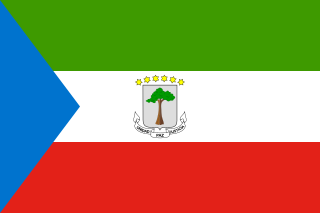
Equatorial Guinea, officially the Republic of Equatorial Guinea, is a country located on the west coast of Central Africa, with an area of 28,000 square kilometres (11,000 sq mi). Formerly the colony of Spanish Guinea, its post-independence name evokes its location near both the Equator and the Gulf of Guinea. Equatorial Guinea is the only sovereign African state in which Spanish is the official language. As of 2015, the country had an estimated population of 1,222,245.

Guinea, officially the Republic of Guinea, is a west-coastal country in West Africa. Formerly known as French Guinea, the modern country is sometimes referred to as Guinea-Conakry in order to distinguish it from other countries with "Guinea" in the name and the eponymous region, such as Guinea-Bissau and Equatorial Guinea. Guinea has a population of 12.4 million and an area of 245,860 square kilometres (94,927 sq mi).

Guinea-Bissau, officially the Republic of Guinea-Bissau, is a country in West Africa that covers 36,125 square kilometres (13,948 sq mi) with an estimated population of 1,815,698.

Papua New Guinea, officially the Independent State of Papua New Guinea, is an Oceanian country that occupies the eastern half of the island of New Guinea and its offshore islands in Melanesia, a region of the southwestern Pacific Ocean north of Australia. Its capital, located along its southeastern coast, is Port Moresby. The western half of New Guinea forms the Indonesian provinces of Papua and West Papua.

The guinea pig or domestic guinea pig, also known as cavy or domestic cavy, is a species of rodent belonging to the family Caviidae and the genus Cavia. Despite their common name, guinea pigs are not native to Guinea, nor are they biologically related to pigs, and the origin of the name is still unclear. They originated in the Andes of South America, and studies based on biochemistry and hybridization suggest they are domesticated descendants of a closely related species of cavy such as C. tschudii, and therefore do not exist naturally in the wild.
Dudgeonea is a small genus of moths and the only genus of its family, the Dudgeoneidae. It includes six species distributed sparsely across the Old World from Africa and Madagascar to Australia and New Guinea.
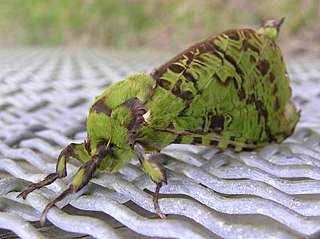
Aenetus is a genus of moths of the family Hepialidae. There are 24 described species found in Indonesia, New Guinea, New Caledonia, Australia and New Zealand. Most species have green or blue forewings and reddish hindwings, but some are predominantly brown or white. The larvae feed in the trunks of living trees, burrowing horizontally into the trunk, then vertically down.

Oxycanus is a genus of moths of the family Hepialidae. There are 71 described species found in Australia and New Guinea.
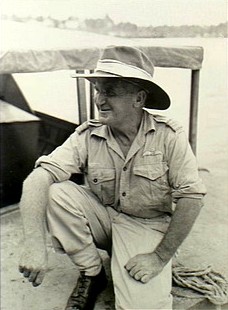
Alexander Augustus Norman Dudley "Jerry" Pentland, MC, DFC, AFC was an Australian fighter ace in World War I. Born in Maitland, New South Wales, he commenced service as a Lighthorseman with the Australian Imperial Force in 1915, and saw action at Gallipoli. He transferred to the Royal Flying Corps the following year, rising to captain. Credited with twenty-three aerial victories, Pentland became the fifth highest-scoring Australian ace of the war, after Robert Little, Stan Dallas, Harry Cobby and Roy King. He was awarded the Military Cross in January 1918 for "conspicuous gallantry and devotion to duty" on a mission attacking an aerodrome behind enemy lines, and the Distinguished Flying Cross that August for engaging four hostile aircraft single-handedly.
Copromorphidae, the "tropical fruitworm moths" is a family of insects in the lepidopteran order. These moths have broad, rounded forewings, and well-camouflaged scale patterns. Unlike Carposinidae the mouthparts include "labial palps" with the second rather than third segment the longest. With other unusual structural characteristics of the caterpillar and adult, it could represent the sister lineage of all other extant members of this superfamily. The genus Sisyroxena from Madagascar is also notable for its unusual venation and wing scale sockets.
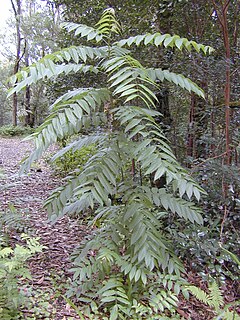
Toona ciliata is a forest tree in the mahogany family which grows throughout southern Asia from Afghanistan to Papua New Guinea and Australia. It is commonly known as the red cedar, toon or toona, Australian red cedar, Burma cedar, Indian cedar, Moulmein cedar or the Queensland red cedar. It is also known as Indian mahogany.

The de Havilland DH.61 Giant Moth was a 1920s British large single-engined biplane transport built by de Havilland at Stag Lane Aerodrome, Edgware. Intended primarily for use in Australia, a number were also shipped to Canada.
Sir George Hamilton Kenrick FRES was an English entomologist who specialised in Lepidoptera especially those of New Guinea. He was a prominent liberal educationist and was a councillor in Birmingham.

The following outline is provided as an overview of and topical guide to Guinea:

New Guinea is a large island separated by a shallow sea from the rest of the Australian continent. It is the world's second-largest island, after Greenland, covering a land area of 785,753 km2 (303,381 sq mi), and the largest wholly or partly within the Southern Hemisphere and Oceania.

Scopulini is a tribe of the geometer moth family (Geometridae), with about 900 species in seven genera. The tribe was described by Philogène Auguste Joseph Duponchel in 1845.
Neochera dominia is a moth in the family Erebidae. It is found from the Indo-Australian tropics from India to Queensland and the Solomons.

Asota heliconia is a moth in the Erebidae family. It is found from the Indo-Australian tropics east to Queensland and the Solomons.
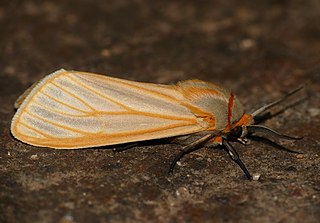
Afromurzinia lutescens is a moth in the family Erebidae. It was described by Francis Walker in 1855. It is found in Angola, Cameroon, the Democratic Republic of the Congo, Equatorial Guinea, Ethiopia, Ghana, Guinea, Guinea-Bissau, Kenya, Nigeria, Sierra Leone, Somalia, South Africa, Tanzania, Togo, Uganda and Zimbabwe.














